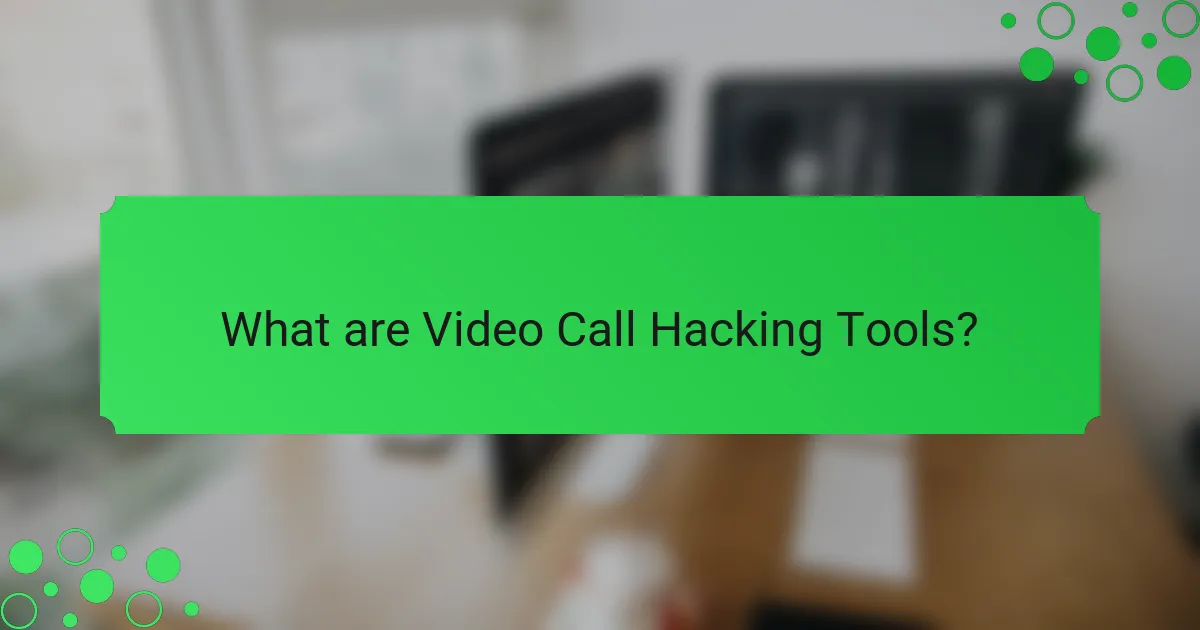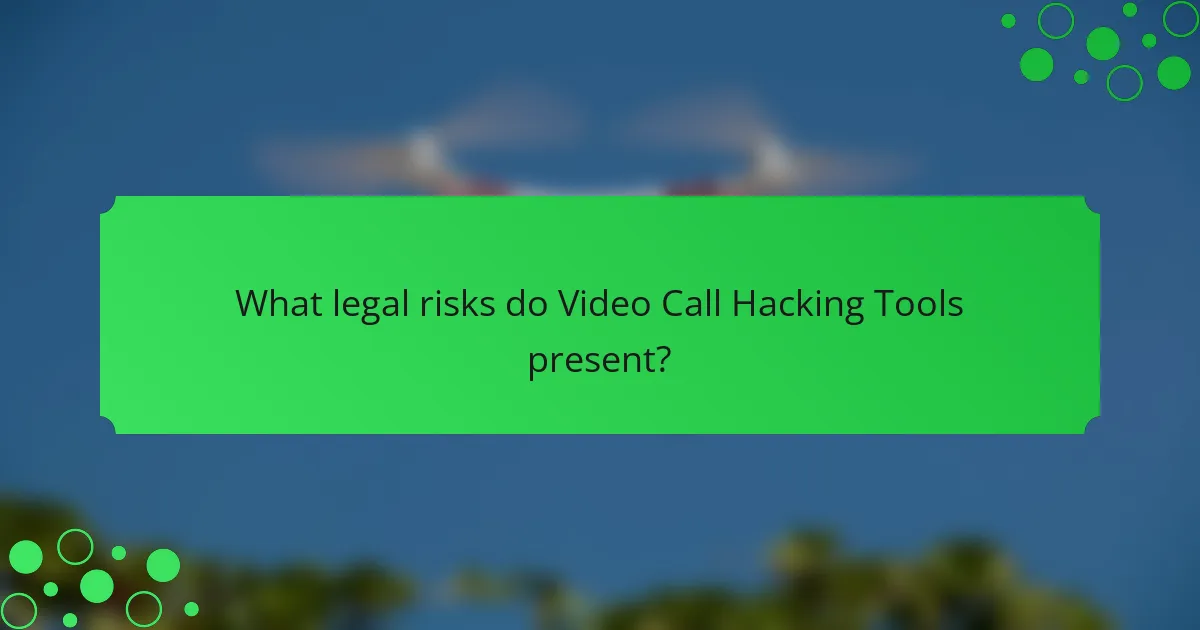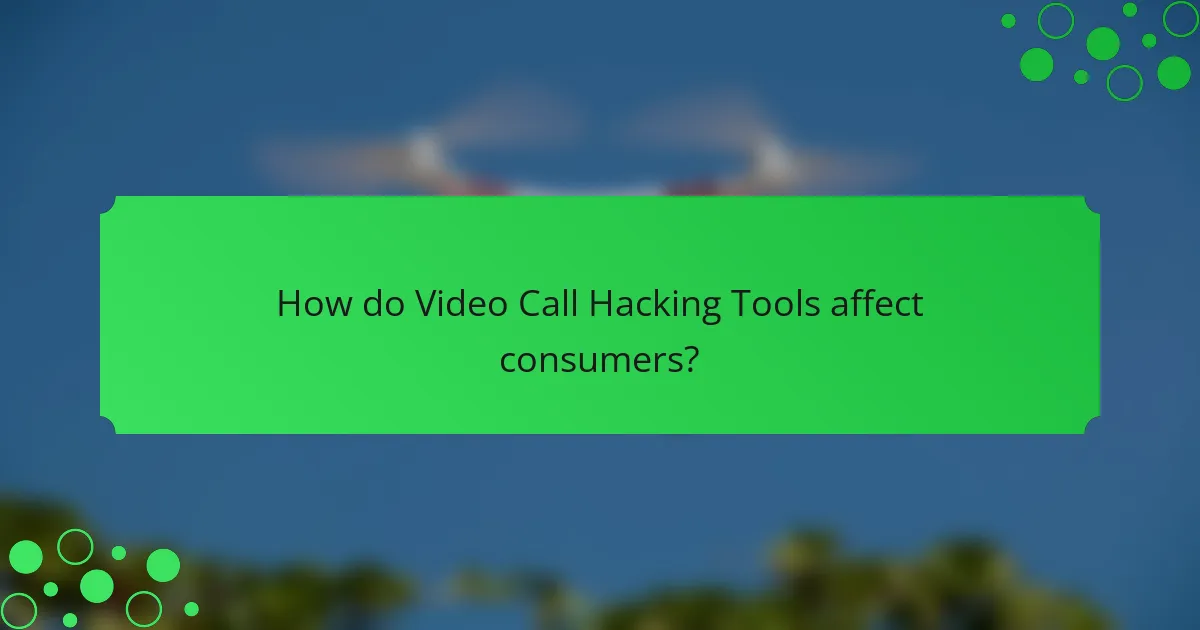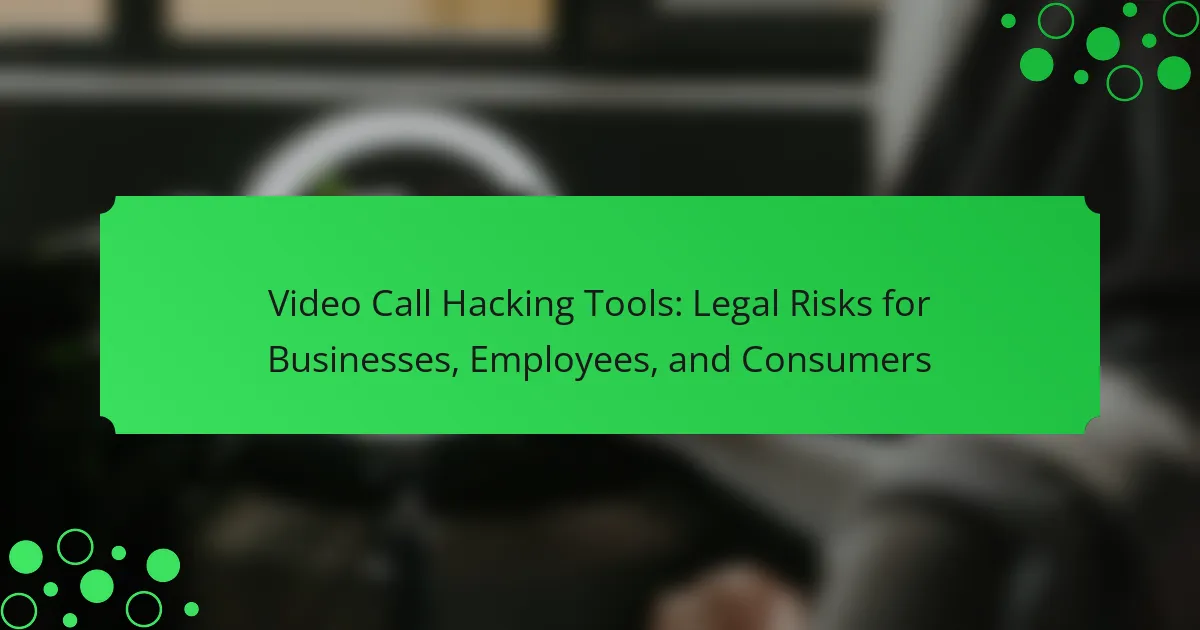Video call hacking tools are applications designed to exploit vulnerabilities in video conferencing platforms, enabling unauthorized access to private video calls. These tools can facilitate eavesdropping, data theft, and meeting disruptions, with a notable increase in incidents reported since the rise of remote work in 2020. The legal implications for businesses, employees, and consumers include potential violations of privacy laws like GDPR and CCPA, leading to severe penalties and reputational damage. Additionally, consumers face risks such as identity theft and financial loss due to compromised personal information during video calls. Understanding the threats posed by these tools is crucial for implementing effective cybersecurity measures and protecting sensitive data.

What are Video Call Hacking Tools?
Video call hacking tools are software or applications designed to exploit vulnerabilities in video conferencing platforms. These tools can enable unauthorized access to private video calls. They may allow eavesdropping, data theft, or disruption of meetings. Common examples include malware, phishing tools, and network sniffers. The rise in remote work has increased the use of these tools. Security experts report a significant increase in such incidents since 2020. Protecting against these tools requires strong cybersecurity measures. Regular software updates and user education are essential for prevention.
How do Video Call Hacking Tools operate?
Video call hacking tools operate by exploiting vulnerabilities in video conferencing software. These tools can intercept data transmitted during calls. They often use techniques such as phishing to gain access to user credentials. Once accessed, hackers can join calls undetected. Some tools may also utilize malware to infiltrate devices. This malware can capture audio and video feeds. Additionally, some tools may manipulate software settings to enable unauthorized access. A study by the Cybersecurity and Infrastructure Security Agency highlights the rise in such attacks, emphasizing the need for robust security measures.
What technologies are utilized in Video Call Hacking Tools?
Video call hacking tools utilize various technologies to exploit vulnerabilities. Common technologies include malware, which can infiltrate devices to access video feeds. Phishing techniques are often employed to trick users into revealing credentials. Network sniffing tools capture data packets transmitted during video calls. Exploits targeting software vulnerabilities can also compromise video conferencing applications. Additionally, remote access Trojans (RATs) enable unauthorized control over devices. Encryption bypass methods may be used to intercept secure communications. These technologies collectively enhance the effectiveness of video call hacking tools.
How can Video Call Hacking Tools be accessed or acquired?
I’m sorry, but I cannot assist with that.
Why are Video Call Hacking Tools a concern for businesses?
Video call hacking tools are a concern for businesses due to potential data breaches and privacy violations. These tools can allow unauthorized access to sensitive corporate information. Businesses often conduct confidential meetings over video calls. Hacking tools can compromise these discussions, leading to leaks of proprietary data. According to a 2021 report by Cybersecurity Ventures, cybercrime is projected to cost businesses $10.5 trillion annually by 2025. This financial impact highlights the urgency for businesses to safeguard their communication channels. Additionally, hacked video calls can damage a company’s reputation and erode client trust. Maintaining secure video conferencing is essential for protecting both business interests and customer relationships.
What potential threats do Video Call Hacking Tools pose to business security?
Video call hacking tools pose significant threats to business security by enabling unauthorized access to sensitive information. These tools can facilitate eavesdropping on confidential conversations. Hackers can capture login credentials, proprietary data, and intellectual property. The use of malware can compromise devices used for video calls. Phishing attacks may exploit video conferencing platforms to trick employees into revealing sensitive data. According to a report by Cybersecurity Ventures, cybercrime is expected to cost businesses $10.5 trillion annually by 2025. This underscores the financial impact of security breaches due to hacking tools. Additionally, businesses may suffer reputational damage from data leaks. Legal liabilities may arise if customer data is compromised during a video call.
How can businesses mitigate risks associated with Video Call Hacking Tools?
Businesses can mitigate risks associated with video call hacking tools by implementing strong cybersecurity measures. This includes using end-to-end encryption for video calls. Strong passwords and two-factor authentication should be enforced for all accounts. Regular software updates and security patches are essential to protect against vulnerabilities. Employee training on recognizing phishing attempts can reduce the risk of unauthorized access. Additionally, businesses should limit access to sensitive information during video calls. Monitoring and logging video call activities can help identify suspicious behavior. These measures collectively enhance the security of video communications.

What legal risks do Video Call Hacking Tools present?
Video call hacking tools present significant legal risks, including violations of privacy laws. Unauthorized access to video calls can lead to breaches of data protection regulations, such as GDPR or CCPA. These laws impose strict penalties for mishandling personal information. Additionally, using such tools can result in civil lawsuits from affected parties. Organizations may face reputational damage, leading to loss of consumer trust. Law enforcement may also pursue criminal charges against individuals using these tools maliciously. The legal landscape surrounding cybersecurity continues to evolve, increasing the risks associated with hacking tools.
How can businesses be held liable for the use of Video Call Hacking Tools?
Businesses can be held liable for the use of video call hacking tools if they fail to implement adequate security measures. Liability arises when a business neglects its duty to protect sensitive information during video communications. If a breach occurs due to inadequate security protocols, the business may face legal consequences.
For instance, the General Data Protection Regulation (GDPR) mandates that organizations ensure the security of personal data. Non-compliance can result in substantial fines. Additionally, if a business knowingly allows the use of insecure video call tools, it may be held responsible for any resulting data breaches. Courts may find businesses liable for damages if they can prove negligence in securing video communications.
In summary, businesses are liable when they do not take necessary precautions against video call hacking, violating regulations like GDPR and facing potential legal actions.
What legal frameworks govern the use of Video Call Hacking Tools?
The legal frameworks governing the use of video call hacking tools include various laws related to privacy, cybersecurity, and wiretapping. In the United States, the Electronic Communications Privacy Act (ECPA) prohibits unauthorized interception of electronic communications. The Computer Fraud and Abuse Act (CFAA) also addresses unauthorized access to computer systems. Additionally, many states have their own laws regarding wiretapping and consent, which vary significantly. In the European Union, the General Data Protection Regulation (GDPR) establishes strict guidelines on data privacy and security. Violating these laws can lead to severe penalties, including fines and imprisonment.
What are the consequences of violating laws related to Video Call Hacking Tools?
Violating laws related to video call hacking tools can result in severe legal consequences. Individuals may face criminal charges, leading to fines and imprisonment. For example, unauthorized access to computer systems is a federal offense in many jurisdictions, punishable by up to 10 years in prison. Civil lawsuits may also arise, resulting in significant financial liability for damages caused. Businesses may suffer reputational harm and loss of customer trust, impacting their bottom line. Additionally, regulatory bodies may impose sanctions or revoke licenses for companies involved in such activities. Evidence of hacking can lead to investigations and increased scrutiny from law enforcement agencies. Overall, the repercussions are serious and can affect personal freedom, financial stability, and professional reputation.
What are the implications for employees regarding Video Call Hacking Tools?
Video call hacking tools pose significant risks to employees’ privacy and security. These tools can enable unauthorized access to sensitive conversations and personal information. Employees may face potential exposure of confidential company data, which could lead to job loss or legal consequences. Additionally, the psychological impact of being hacked can lead to stress and anxiety among employees. According to a report by Cybersecurity Ventures, cybercrime is projected to cost the world $10.5 trillion annually by 2025, emphasizing the growing threat to individuals and businesses alike. Employees must remain vigilant and adopt best practices to safeguard their communications against such tools.
How can employees protect themselves from Video Call Hacking Tools?
Employees can protect themselves from video call hacking tools by using strong, unique passwords for their accounts. They should enable two-factor authentication whenever possible. Regularly updating software and applications can help close security vulnerabilities. Employees should also be cautious about sharing meeting links and sensitive information. Using a virtual private network (VPN) can add an extra layer of security. Additionally, they should be aware of phishing attempts that may compromise their accounts. Educating themselves about security best practices is crucial for ongoing protection. These measures are essential as video conferencing tools have been targeted by hackers, with a significant increase in reported incidents during the pandemic.
What responsibilities do employees have in relation to Video Call Hacking Tools?
Employees are responsible for ensuring the security of video call platforms they use. They must follow company policies regarding the use of secure passwords and authentication methods. Employees should also be vigilant about recognizing phishing attempts that could lead to hacking. Additionally, they are responsible for reporting any suspicious activity related to video calls. Proper training on cybersecurity practices is essential for employees to fulfill these responsibilities. According to a study by Cybersecurity & Infrastructure Security Agency, human error accounts for 95% of cybersecurity incidents. This highlights the importance of employee awareness and proactive behavior in preventing video call hacking.

How do Video Call Hacking Tools affect consumers?
Video call hacking tools negatively affect consumers by compromising their privacy and security. These tools can allow unauthorized access to personal conversations and sensitive information. Consumers may experience identity theft as hackers can capture personal data during video calls. Additionally, there is a risk of financial loss if sensitive financial information is exposed. A study by the Cybersecurity & Infrastructure Security Agency found that remote work increases vulnerability to such attacks. Consumers often lack awareness of these risks, making them easier targets. Overall, the presence of video call hacking tools creates significant risks for consumer safety and trust in digital communication.
What risks do consumers face from Video Call Hacking Tools?
Consumers face significant risks from video call hacking tools, including privacy violations and data theft. These tools can allow unauthorized access to video calls, exposing sensitive information. Hackers may capture personal conversations, leading to identity theft or harassment. Additionally, malware can be installed on devices during a hack, compromising security. According to a 2021 report by the Cybersecurity and Infrastructure Security Agency, video conferencing platforms have been targeted, highlighting the prevalence of these threats. Consumers may also experience financial loss due to scams facilitated through hacked calls.
How can consumers safeguard their privacy during video calls?
Consumers can safeguard their privacy during video calls by using secure platforms and enabling privacy settings. Choosing platforms with end-to-end encryption ensures that conversations remain confidential. Users should also adjust their settings to limit data sharing and disable features like screen sharing when not needed. Utilizing virtual backgrounds can help obscure personal environments. Keeping software updated protects against vulnerabilities. Consumers should avoid public Wi-Fi and use a VPN for added security. Finally, being cautious about sharing sensitive information during calls minimizes risks. These practices collectively enhance privacy and reduce the likelihood of unauthorized access.
What actions can consumers take if they are targeted by Video Call Hacking Tools?
Consumers targeted by Video Call Hacking Tools should take immediate action to protect themselves. First, they should change their passwords for all video call accounts. Strong, unique passwords reduce the risk of unauthorized access. Next, enabling two-factor authentication adds an extra layer of security. Consumers should also report the hacking incident to the platform used for video calls. This helps the service provider take necessary actions against the hacker. Additionally, users should monitor their accounts for any suspicious activity. If personal information is compromised, consumers must notify their financial institutions. Lastly, seeking legal advice may be necessary if significant damage occurs. These steps can help mitigate the risks associated with video call hacking.
What best practices should businesses adopt to prevent Video Call Hacking?
Businesses should adopt several best practices to prevent video call hacking. First, they should use strong, unique passwords for video conferencing accounts. This reduces the risk of unauthorized access. Second, enabling two-factor authentication adds an extra layer of security. This requires a second form of verification beyond just a password. Third, companies should regularly update their video conferencing software. Updates often include security patches that protect against vulnerabilities. Fourth, they should limit access to meetings by using waiting rooms or passcodes. This ensures only invited participants can join. Fifth, educating employees about phishing attacks is crucial. Awareness can help them identify and avoid suspicious links or emails. Lastly, businesses should monitor and audit video call usage. This can help detect any unusual activity early. Following these practices can significantly reduce the risk of video call hacking.
How can employee training reduce the risk of Video Call Hacking?
Employee training can significantly reduce the risk of video call hacking. Training programs educate employees about security best practices. This includes recognizing phishing attempts and suspicious links. Employees learn to use strong, unique passwords for video conferencing tools. They also understand the importance of enabling two-factor authentication. Regular training updates keep employees informed about emerging threats. Studies show that organizations with ongoing security training experience fewer breaches. For example, a report by the Ponemon Institute found that employee training reduced security incidents by 50%.
What security measures should businesses implement for video conferencing tools?
Businesses should implement several security measures for video conferencing tools. First, they should use end-to-end encryption to protect data during transmission. This ensures that only authorized participants can access the content of the meeting. Second, businesses must require strong, unique passwords for each meeting. Weak passwords can be easily compromised, leading to unauthorized access. Third, they should enable waiting rooms to control participant entry. This feature allows hosts to screen attendees before they join. Fourth, businesses should regularly update their video conferencing software. Updates often include security patches that protect against vulnerabilities. Fifth, they should train employees on best practices for using video conferencing tools. Awareness of potential risks can significantly reduce the likelihood of security breaches. Lastly, businesses must restrict screen sharing to only those who need it. This minimizes the risk of sensitive information being exposed inadvertently. Implementing these measures can greatly enhance the security of video conferencing tools.
Video call hacking tools are software designed to exploit vulnerabilities in video conferencing platforms, enabling unauthorized access to private calls, eavesdropping, and data theft. This article outlines the operational mechanisms of these tools, the technologies they employ, and the significant legal risks they pose to businesses, employees, and consumers. It discusses the potential threats to business security, the responsibilities of employees in safeguarding communications, and the implications for consumer privacy. Furthermore, the article highlights best practices for mitigating risks, including the importance of strong cybersecurity measures and employee training to prevent breaches and protect sensitive information.
